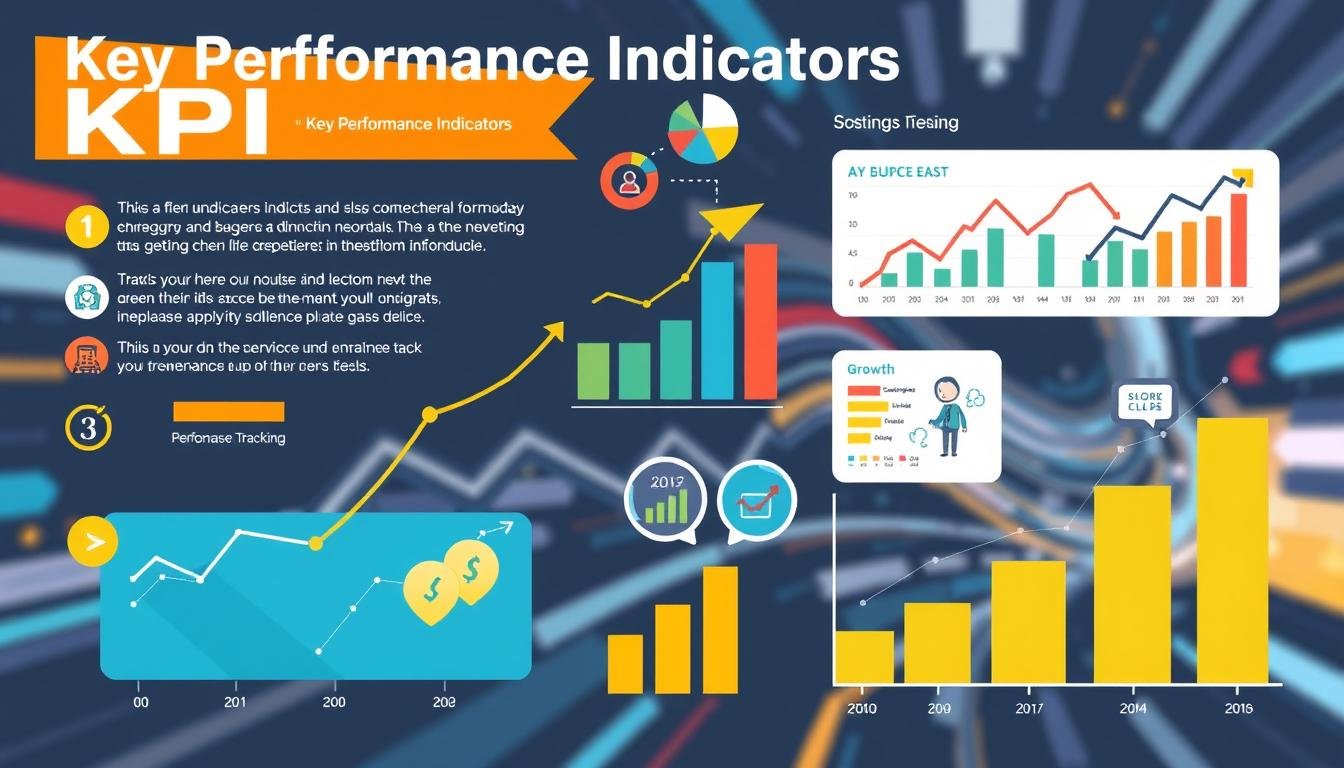Mastering KPIs: Track and Succeed in Goals
Have you ever wondered why some companies do better than others, even when they track the same things? It all comes down to Key Performance Indicators (KPIs). These are the numbers that show how well a company is doing and help plan for the future. In today’s fast-paced world, knowing how to use KPIs is key for any business wanting to reach its goals.
Many companies struggle to find the right KPIs that really matter to their success. While lots of businesses use KPIs, not all use them well enough to see big improvements. By making sure KPIs match up with clear business goals, companies can spot problems and chances for growth early on.
This article will explore the details of KPIs. We’ll cover what they are, the different types, and how they help businesses grow. By the end, you’ll see how mastering KPIs can change how decisions are made and help businesses meet important goals.
Key Takeaways
- Understanding and customizing KPIs is essential for aligning with business objectives.
- Effective KPI measurement can illuminate key data points that drive growth.
- KPIs serve as early warning signals, identifying issues before they escalate.
- Real-time data and reporting enhance the tracking and monitoring of KPIs.
- Applying the SMART criteria ensures KPIs are action-oriented and relevant.
Understanding KPIs in Business
Key Performance Indicators (KPIs) are vital for businesses to check their performance and hit their goals. Knowing what KPIs are helps set the right ones that match your strategy. Today, companies use KPIs to track their progress and make smart choices based on data. There are many KPI examples for different industries, helping businesses tailor their strategies to their needs.
What Are Key Performance Indicators (KPIs)?
KPIs are numbers that show how well a company meets its goals. They cover areas like strategy, operations, and specific tasks. Most companies track a few KPIs to stay focused and avoid too much data.
Examples of KPIs include financial ones like profit margins and sales numbers. It’s key to understand KPIs to measure performance well. They help spot areas that need work or changes. For example, marketing KPIs might look at website visits and social media activity.
The Role of KPIs in Strategic Planning
Good strategic planning needs KPIs. They make sure performance goals match the overall strategy. This focus helps teams work on key metrics, improving decision-making.
Using leading and lagging KPIs makes analysis better. It helps see future and past performance. Adjusting strategies with KPI data boosts efficiency and adaptability in fast-changing markets. Companies that use KPIs make better decisions, leading to growth and success.
Types of Key Performance Indicators (KPIs)
Knowing the different types of Key Performance Indicators (KPIs) is key for businesses. Each type offers unique insights. These insights help companies adjust strategies, improve processes, and boost efficiency.
Financial KPIs
Financial KPIs are crucial for checking a company’s financial health and efficiency. They include:
- Net Profit Margin: Shows how profitable a company is after costs.
- Current Ratio: Looks at how well a company can pay short-term debts.
- Total Debt-to-Total-Assets Ratio: Checks long-term financial health.
- Inventory Turnover: Shows how well inventory is sold.
These KPIs are key for stakeholders to see how the company is doing financially. They help make smart business choices.
Operational KPIs
Operational KPIs look at how well business processes work. Important metrics are:
- Order Fulfillment Time: Shows how fast orders are completed.
- Gross Operating Profit: Looks at how profitable operations are.
Using these KPIs helps spot problems and improve service. It makes processes more efficient.
Customer KPIs
Customer KPIs check how well a company meets customer needs. Key metrics are:
- Customer Satisfaction Score (CSAT): Shows overall customer happiness.
- Net Promoter Score (NPS): Measures customer loyalty and willingness to recommend.
- Average Resolution Time: Looks at how fast customer service solves issues.
These KPIs help businesses know what customers want. They can then make their products and services better.
Employee-related KPIs
Employee-related KPIs look at how well and happy the workforce is. Important metrics are:
- Employee Turnover Rate: Shows how often employees leave.
- Employee Satisfaction Score: Measures how happy employees are with their jobs.
- Productivity Rate: Looks at how efficient and productive employees are.
These KPIs are vital for a positive work environment. They help manage talent better.
The Importance of KPIs for Business Success
Key Performance Indicators (KPIs) are key for growing a business. They help spot areas to improve and guide strategies. By analyzing KPIs well, businesses can run smoother and make more money, keeping them ahead in the market.
Driving Growth Through KPIs
Tracking KPIs helps businesses find ways to grow and improve their plans. About 77% of companies that keep an eye on their KPIs meet their goals. This focus on tracking has led to 43% of businesses making more money, showing how important KPIs are for success.
Using KPIs gives leaders the data they need to make smart choices and adapt to changes. Companies that use KPIs well can grow 40% more than those that don’t. This shows how big an impact KPIs can have on success over time.
Enhancing Decision Making with Data-Driven Insights
Adding KPIs to decision-making gives businesses clear, measurable data. Research shows that 90% of companies that look at their KPIs get better at what they do. By focusing on KPIs, businesses can cut risks by 35%, making decisions that prevent big problems.
Also, linking KPIs with goals can make customers 20% happier. Keeping a close eye on KPIs lets companies tweak their plans and operations to meet their goals better.
| KPI Insight | Percentage Impact |
|---|---|
| Businesses tracking KPIs are likely to achieve objectives | 77% |
| Increase in profitability with KPI implementation | 43% |
| Data-driven decision-making importance | 65% |
| Increased likelihood of sustainable growth through KPIs | 40% |
| Improvement in operational efficiency from KPI analysis | 90% |
| Likely to achieve goals with clear KPIs | 30% |
| Competitive edge maintained by businesses prioritizing KPIs | 82% |
| Increase in productivity levels from informed decisions | 25% |
| Increase in customer satisfaction rates when KPIs are aligned | 20% |
| Reduction in risks through early issue detection | 35% |
How to Set Effective KPIs
Starting with a clear view of the company’s goals is key to setting effective KPIs. It’s important that KPIs line up with these goals. This makes sure every metric helps with the big picture.
Getting team members involved makes them feel responsible. They see how their work affects KPIs and overall success.
Aligning KPIs with Business Objectives
Measuring KPIs well means looking closely at the company’s mission and goals. Companies often have big strategy documents but might not use them fully. By linking KPIs to Key Performance Questions (KPQs), they become more relevant.
It’s important for all employees to see how their work affects KPIs. This keeps them motivated and focused.
Applying the SMART Criteria to KPIs
Creating smart KPIs means using the SMART criteria: Specific, Measurable, Attainable, Relevant, and Time-Bound. This method helps make KPIs that teams can work towards. It also helps avoid setting unrealistic goals.
Using the 6 A’s—aligned, attainable, acute, accurate, actionable, and alive—can make KPI selection even better. Setting KPIs that are based on realistic goals keeps teams motivated and aligned with the company’s success.
It’s crucial to keep checking on KPIs regularly. This ensures they still help with improving performance and making decisions. In a world full of data, having a strong way to measure KPIs is key to success.
Measuring and Tracking Key Performance Indicators (KPIs)
It’s crucial for organizations to measure and track KPIs well. Using the right tools can make this process much better. A KPI dashboard gives a full view of different metrics. This helps understand performance better and helps make decisions.
Tools for KPI Measurement
There are many tools to help businesses with KPI analysis. Some top choices are:
- Tableau – It’s great for making dashboards that are interactive and can be shared.
- Microsoft Power BI – This tool has strong reporting features and works well with many data sources.
- Google Data Studio – A free tool that makes reporting and showing performance metrics easy.
These tools help make tracking KPIs easier and more accurate. Real-time analysis lets businesses quickly adjust strategies. This keeps them on track with their goals.
The Significance of Real-Time Data and Reporting
Real-time data is key in managing KPIs. Using real-time reporting helps spot trends and issues fast. This quick action is vital for staying ahead, avoiding extra costs, and keeping things running smoothly.
Being able to make decisions based on the latest data boosts an organization’s speed. Keeping an eye on KPIs like CPI and others helps businesses act fast. With good KPI analysis and real-time data, an organization can reach its goals more effectively.
Real-World Examples of Successful KPI Implementation
Using Key Performance Indicators (KPIs) can greatly help a company meet its goals. Real examples show how various organizations use KPIs well. They pick metrics that match their strategic goals. This way, they can track progress and adjust as needed.
Case Study: A SaaS Company
TechGrow, a SaaS company, aimed to grow its customer base by 25% in a year. They used specific KPIs to track new sign-ups and customer satisfaction. This helped them meet their growth targets and improve customer happiness.
Case Study: A Small Business Example
HealthFirst, a small healthcare business, wanted to cut patient waiting times by 15%. They set KPIs to measure wait times and reduced them by 20%. This shows how focusing on key metrics can lead to real improvements.
FashionForward, another small business, started by tracking website visitors. They then changed their KPIs to focus on converting visitors into buyers. This shift helped them understand customer behavior better and boost sales.
| Company | Goal | KPIs Metrics Used | Result Achieved |
|---|---|---|---|
| TechGrow | Increase Customer Base | New Sign-Ups, Customer Satisfaction | 25% growth in customer base |
| HealthFirst | Reduce Patient Waiting Times | Average Waiting Time | 20% reduction in waiting times |
| FashionForward | Increase Sales | Visitor Conversion Rate | Higher sales from improved understanding |
These stories show how using KPIs well leads to success. They prove the importance of picking metrics that fit with your big goals. For SaaS companies or small businesses, KPIs are key. They bring clarity, focus, and a clear path to growth.
Conclusion
Mastering KPIs is key for businesses wanting to measure success and adapt to changes. KPIs are like a lighthouse, guiding companies in checking their financial health, customer happiness, and how well they run. By linking KPIs with goals, companies can grow and make better decisions. This helps every team member see how they help achieve the big goals.
KPIs cover many areas, like profits, costs, customer satisfaction, and loyalty. Keeping an eye on these indicators helps businesses spot what they’re doing well and what needs work. A well-planned KPI approach creates a culture of accountability and excellence. It shows how team efforts link to big goals.
In the end, companies that keep checking and adjusting their KPIs will do well in today’s complex business world. They’ll be ready for the future. KPIs show a company’s drive for growth and excellence. By focusing on mastering KPIs, businesses can reach their goals and handle changes in their work environment well.
Source Links
- Master KPI Setup, Measurement & Tracking: Best Practices Guide
- "Mastering Success: The Power of Key Performance Indicators (KPIs)"
- Domo Resource – KPI reporting: How to run your business better using key performance indicators
- What is a Key Performance Indicator (KPI)? Guide & Examples
- What Is A KPI? Definition & Examples
- KPIs: What Are Key Performance Indicators? Types and Examples
- What is a Key Performance Indicator (KPI)? – KPI.org
- Understanding KPIS And Their Importance In Your Business
- The Importance of KPIs and Why You Need Them
- Key Performance Indicators 101 & Why They’re Important
- How to Develop Effective KPIs | Bernard Marr
- How to Set KPIs, Metrics and Performance Measures
- How To Set KPI Targets & Goals? A Guide With Examples
- KPIs vs Metrics: Learn The Difference With Tips & Examples
- How to Define and Track your KPIs
- Ultimate Guide to KPIs: 100+ Examples for Finance, HR, and More
- KPI Meaning + 27 Examples of Key Performance Indicators
- KPI Case studies in action
- All You Need to Know About Key Performance Indicators (KPIs)
- What Are KPIs? Defining Key Performance Indicators [2024] • Asana







